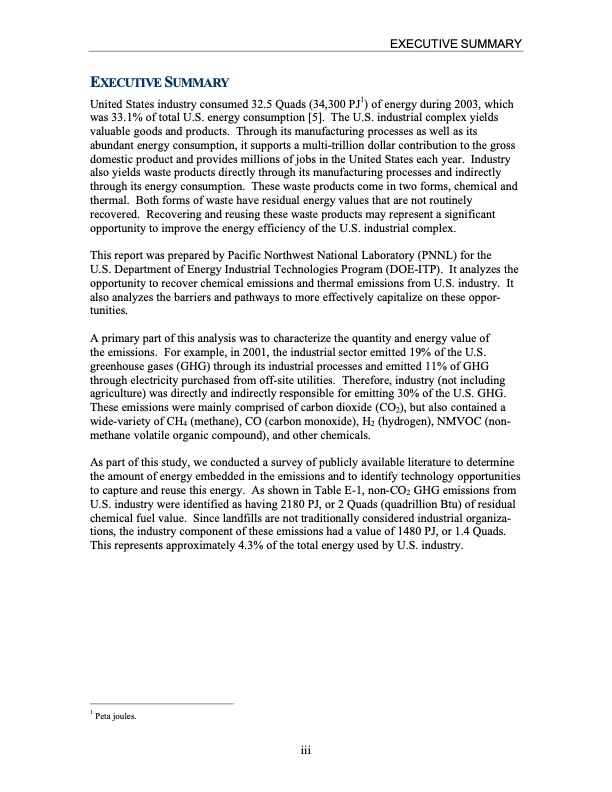
PDF Publication Title:
Text from PDF Page: 004
EXECUTIVE SUMMARY United States industry consumed 32.5 Quads (34,300 PJ1) of energy during 2003, which was 33.1% of total U.S. energy consumption [5]. The U.S. industrial complex yields valuable goods and products. Through its manufacturing processes as well as its abundant energy consumption, it supports a multi-trillion dollar contribution to the gross domestic product and provides millions of jobs in the United States each year. Industry also yields waste products directly through its manufacturing processes and indirectly through its energy consumption. These waste products come in two forms, chemical and thermal. Both forms of waste have residual energy values that are not routinely recovered. Recovering and reusing these waste products may represent a significant opportunity to improve the energy efficiency of the U.S. industrial complex. This report was prepared by Pacific Northwest National Laboratory (PNNL) for the U.S. Department of Energy Industrial Technologies Program (DOE-ITP). It analyzes the opportunity to recover chemical emissions and thermal emissions from U.S. industry. It also analyzes the barriers and pathways to more effectively capitalize on these oppor- tunities. A primary part of this analysis was to characterize the quantity and energy value of the emissions. For example, in 2001, the industrial sector emitted 19% of the U.S. greenhouse gases (GHG) through its industrial processes and emitted 11% of GHG through electricity purchased from off-site utilities. Therefore, industry (not including agriculture) was directly and indirectly responsible for emitting 30% of the U.S. GHG. These emissions were mainly comprised of carbon dioxide (CO2), but also contained a wide-variety of CH4 (methane), CO (carbon monoxide), H2 (hydrogen), NMVOC (non- methane volatile organic compound), and other chemicals. As part of this study, we conducted a survey of publicly available literature to determine the amount of energy embedded in the emissions and to identify technology opportunities to capture and reuse this energy. As shown in Table E-1, non-CO2 GHG emissions from U.S. industry were identified as having 2180 PJ, or 2 Quads (quadrillion Btu) of residual chemical fuel value. Since landfills are not traditionally considered industrial organiza- tions, the industry component of these emissions had a value of 1480 PJ, or 1.4 Quads. This represents approximately 4.3% of the total energy used by U.S. industry. 1 Peta joules. iii EXECUTIVE SUMMARYPDF Image | Analysis for Recovering Energy from Industrial Waste Heat

PDF Search Title:
Analysis for Recovering Energy from Industrial Waste HeatOriginal File Name Searched:
PNNL_15803.pdfDIY PDF Search: Google It | Yahoo | Bing
NFT (Non Fungible Token): Buy our tech, design, development or system NFT and become part of our tech NFT network... More Info
IT XR Project Redstone NFT Available for Sale: NFT for high tech turbine design with one part 3D printed counter-rotating energy turbine. Be part of the future with this NFT. Can be bought and sold but only one design NFT exists. Royalties go to the developer (Infinity) to keep enhancing design and applications... More Info
Infinity Turbine IT XR Project Redstone Design: NFT for sale... NFT for high tech turbine design with one part 3D printed counter-rotating energy turbine. Includes all rights to this turbine design, including license for Fluid Handling Block I and II for the turbine assembly and housing. The NFT includes the blueprints (cad/cam), revenue streams, and all future development of the IT XR Project Redstone... More Info
Infinity Turbine ROT Radial Outflow Turbine 24 Design and Worldwide Rights: NFT for sale... NFT for the ROT 24 energy turbine. Be part of the future with this NFT. This design can be bought and sold but only one design NFT exists. You may manufacture the unit, or get the revenues from its sale from Infinity Turbine. Royalties go to the developer (Infinity) to keep enhancing design and applications... More Info
Infinity Supercritical CO2 10 Liter Extractor Design and Worldwide Rights: The Infinity Supercritical 10L CO2 extractor is for botanical oil extraction, which is rich in terpenes and can produce shelf ready full spectrum oil. With over 5 years of development, this industry leader mature extractor machine has been sold since 2015 and is part of many profitable businesses. The process can also be used for electrowinning, e-waste recycling, and lithium battery recycling, gold mining electronic wastes, precious metals. CO2 can also be used in a reverse fuel cell with nafion to make a gas-to-liquids fuel, such as methanol, ethanol and butanol or ethylene. Supercritical CO2 has also been used for treating nafion to make it more effective catalyst. This NFT is for the purchase of worldwide rights which includes the design. More Info
NFT (Non Fungible Token): Buy our tech, design, development or system NFT and become part of our tech NFT network... More Info
Infinity Turbine Products: Special for this month, any plans are $10,000 for complete Cad/Cam blueprints. License is for one build. Try before you buy a production license. May pay by Bitcoin or other Crypto. Products Page... More Info
| CONTACT TEL: 608-238-6001 Email: greg@infinityturbine.com | RSS | AMP |